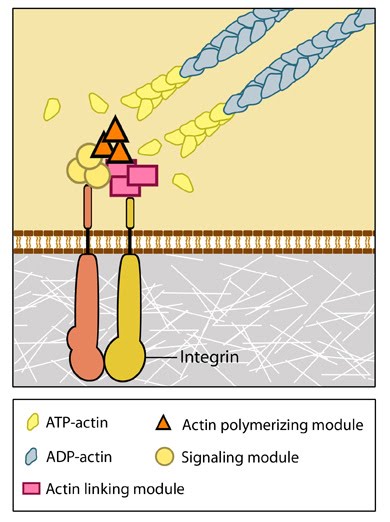Glossary Term: Adhesion receptors/ molecules
Read Further…
Adhesion receptors are crucial in the function of Cell-Matrix Adhesions and cell adhesion molecules in Cell-Cell Interactions
Integral proteins on the cell surface that mediate cell-matrix
contacts through ligand binding are termed adhesion receptors, while those that mediate cell-cell contacts by binding similar partner proteins are referred to as adhesion molecules.
Cell-Matrix Receptors
These receptor-ligand interactions link the intracellular space to the extracellular space to help relay information to the cell interior about the surroundings. The initial attachment of exterior portion of the adhesion receptor to ECM molecules (e.g. fibronectin, collagen) causes their structural rearrangement [1] according to the chemistry (reviewed in [2]), topography [3, 4, 5] (reviewed in [6, 7, 8]), and rigidity of the ECM components [9, 10]. This is followed by the rapid association of other proteins to the intracellular portion of the receptor; this reinforcement of the adhesion domain is controlled by adhesion receptor mobility in the membrane [11]. Such change in forces can affect mechanosensory molecules to activate intracellular signal transduction cascades (e.g. the Rho family of GTPases) and mechanotransduction events that mediate a number of diverse processes such as cell proliferation, fate, migration, shape and polarization [12, 10] (reviewed in [13, 6, 14, 15, 16]).- Fibronectin receptors This group includes the most common type of adhesion receptor. E.g., integrin family and the syndecan family of transmembrane proteoglycans.
- Collagen receptors This group includes integrins, receptor tyrosine kinases (e.g. discoidin domain receptors [DDRs]), glycoproteins (e.g. GPVI) and immunoglobulin-like proteins aka IgCAMs (e.g. LAIR-1).
- Laminin receptors This group includes integrins, the dystrophin glycoprotein complex (DGC), the 67 kDa laminin receptor (67LR), and two glycoproteins belonging to the immunoglobulin superfamily, Lutheran (Lu) and basal cell adhesion molecule (B-CAM).
- Hyaluronan receptors (aka hyaladherins) Proteins that bind to hyaluronan, a large polysaccharide, have immunoglobulin-like domains and include members of the CD44 family and CD168.
Figure: Integrins as adhesion receptor in focal adhesion (FA). Integrins
upon binding to ECM ligand gets activated and undergoes conformational
changes. This leads to a series of events including i) recruitment of
binding proteins to the site leading to actin linking, ii) activation of
signaling molecules leading to integrin clustering and iii) actomyosin
contractions leading to adhesion strengthening. All these result in iv)
formation of new actin filaments by actin polymerization
modules.Cell-matrix
adhesion receptors are grouped according to the ligand that is bound.
In some cases, adhesion receptors bind more than one type of ligand
(e.g. the integrin family) and different receptor groups may cooperate
with each other to bind their ligands (reviewed in [17, 18]).
CAMs cluster into discrete regions on the cellular plasma membrane together with numerous cytoplasmic adaptor proteins to form modular assemblies that link the plasma membrane to the cytoskeleton; these anchoring junctions are dynamic, they vary in their adhesion strength and lifetime, and they are important for regulating tissue integrity and cellular motility.
CAMs are grouped into four main families:
Cell adhesion molecules (CAMs)
CAMs have many distinct domains that allow them to mediate cell-cell contacts by binding to specific partner proteins; when these interactions occur between apposed cells they are described as either homophilic (i.e. binding to the same kind of CAM molecule) or heterophilic (binding to a different kind of CAM molecule). Furthermore, CAMs can mediate interactions between cells of the same type (aka homotypic adhesion) or between different cell types (aka heterotypic adhesion).CAMs cluster into discrete regions on the cellular plasma membrane together with numerous cytoplasmic adaptor proteins to form modular assemblies that link the plasma membrane to the cytoskeleton; these anchoring junctions are dynamic, they vary in their adhesion strength and lifetime, and they are important for regulating tissue integrity and cellular motility.
CAMs are grouped into four main families:
- Cadherins Mediate primarily homophilic interactions at cell-cell adhesions
- Immunoglobulin superfamily (Ig) CAMs Mediate homophilic interactions at cell-cell adhesions
- Integrins Some integrin types mediate heterophilic cell-cell interactions
- Selectins Mediate heterophilic interactions at cell-cell adhesions

